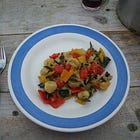April Peels (2025)
coastlines, moorlands, grasslands, a study in contrasts; books, recipes for plenty
bonjour, you. if you’re new to The Onion Papers, Peels are a round-up feature at TOP, a writer’s almanac featuring bread, soil, reading and sky updates that comes out on the first Monday of each month. happy reading and clicking,
margaux
This one didn’t fool anyone. A rainy day in April brings May’s wildflowers as Earth’s hair is thickening with textured grasslands and the gorse plant bloomed sweeter than honey. Her scent is for coconut, brushing the air on a breezeless day, ducklings paddling in the canal and the laundry drying outside in the communal garden. Most of the flat windows remain open; the one neighbour typing hard on their keyboard and the other smoking sitting on the bench where I drink my coffee, the occasional shower, a sigh, a sneeze, the ringtone of a Teams meeting. If mornings don’t carry the overnight frost no more, the dew wears thick pearls as the temperatures keep rising, wet pollen staggering in a mousse, like spring snowflakes on the side of the footpaths. In the garden, the cavolo nero has stretched high but the fennel plant is taller and more fragrant; the rosemary is in flower, though mine has moved house plenty enough to grow shy with her roots; the sage leaves are wide and rough, daring tongues scooping each raindrop as they fall. April was dry with two heatwaves too, nurturing pale lavender bushes, the public bins bursting with tins and pizza boxes. This month, I took many trains, crossing the UK from North to South, across its moorlands and back, from west to westerner points, from the mainland on to boarding ferries for the Scottish islands – and I returned. It is then that I noticed small variations in how the tree at the front of the building flowered this year, that I caught a new wild garlic patch with my nostrils, walking somewhere familiar with a keen eye, renewed. Here we (you, me) go: a gentle reminder to always set a draft aside before editing it. To allow time for anything new to be and to show its true self before forming an opinion; to let that risotto set, heat off, before eating it, to awake spices in a dry pan before sizzling them in fat, to simmer that soup over a low heat, and to hydrate the couscous well enough so it can bloom (a squeeze of lemon, too). Distance is a flirt, teasing, tantalising, testing; unfathomable, desirable all at once.

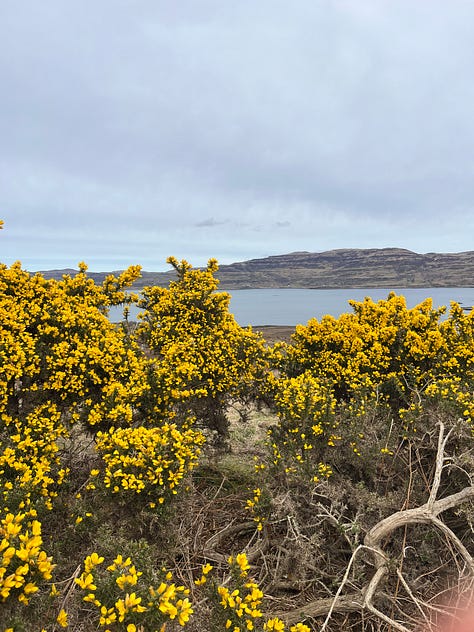


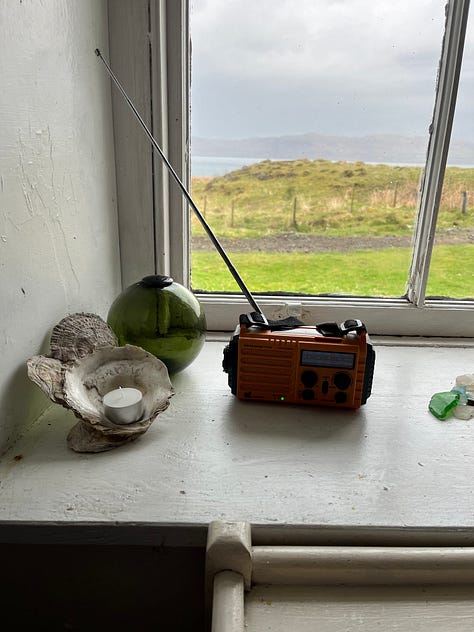
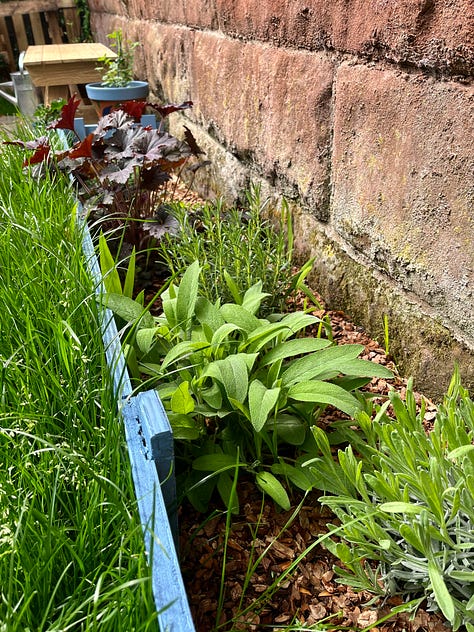
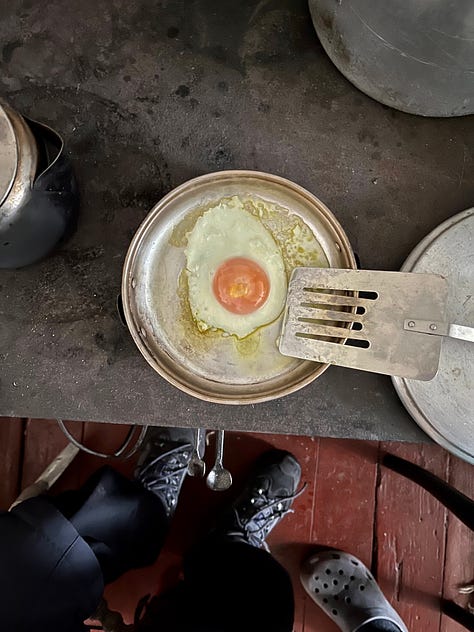
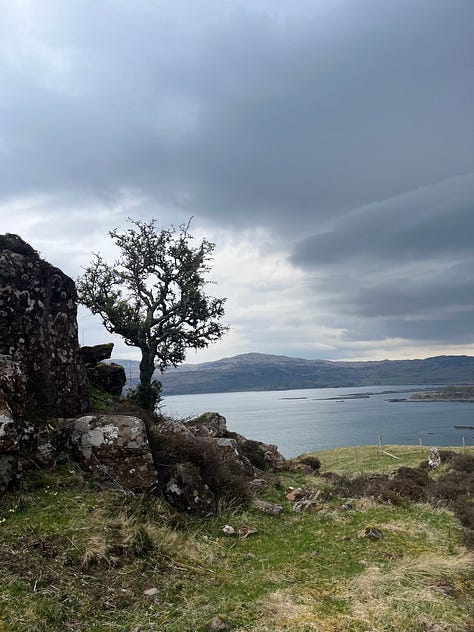

bread update
Time away from my kitchen has meant no sourdough bread making for me. I resorted to baking pre-fermented loaves instead, using a ‘biga’, and there is something to be said about the smell of yeast – as sharp as a beach during the low tide, easy to forget but so memorable as soon as it is met again.
A biga is a low-hydration, slow-fermentation process that is traditionally used for rich and dense Italian breads, like a ciabatta, and only requires store-bought yeast. In a large bowl, mix 400g of strong white bread flour, half a teaspoon of instant dried yeast and 250g of cold water (nb. the water must be cold at this stage, as we don’t want to rush the fermentation). Cover the young biga with a kitchen towel and let it rise for approx. 12 hours. I opt for an overnight fermentation.
The next day, or when you’re ready, mix 100g of wholemeal flour with 10g of salt and half a teaspoon of instant dried yeast. Stir in 100g of lukewarm water and mix well. Combine that mixture with the overnight biga with your hands. Form a ball and let the dough rest under a kitchen towel.
Over the next 3 hours, you will need to fold the dough three times to activate the gluten. Between each stretch and fold, cover the dough with a kitchen towel and let it rest. By the last fold, you should feel the dough getting firmer.
On a well-floured surface, shape your dough in a neat ball. Keep it warm by wrapping it inside a kitchen towel (or a proofing basket if you have one; I use a Pyrex bowl and a floured kitchen towel) and set aside. Let it proof for one-to-two hours, or until it will pass the poke test. Once ready, return the dough to a floured surface, shape and score. Preheat the oven to 200-220C, or high as it will go. In an oven-proofed casserole, bake the dough (lid on) for 30 minutes, followed by another 20 minutes (lid off).
This bread makes excellent toasties.
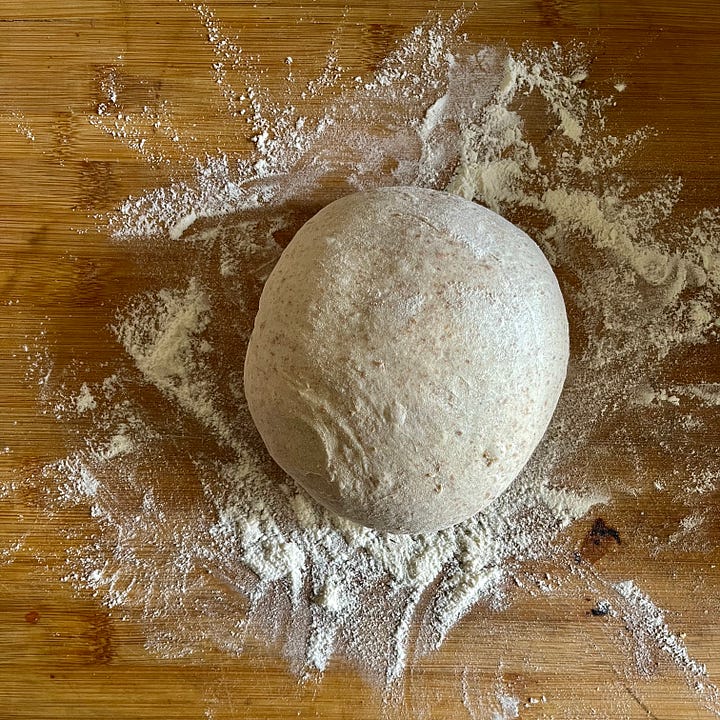
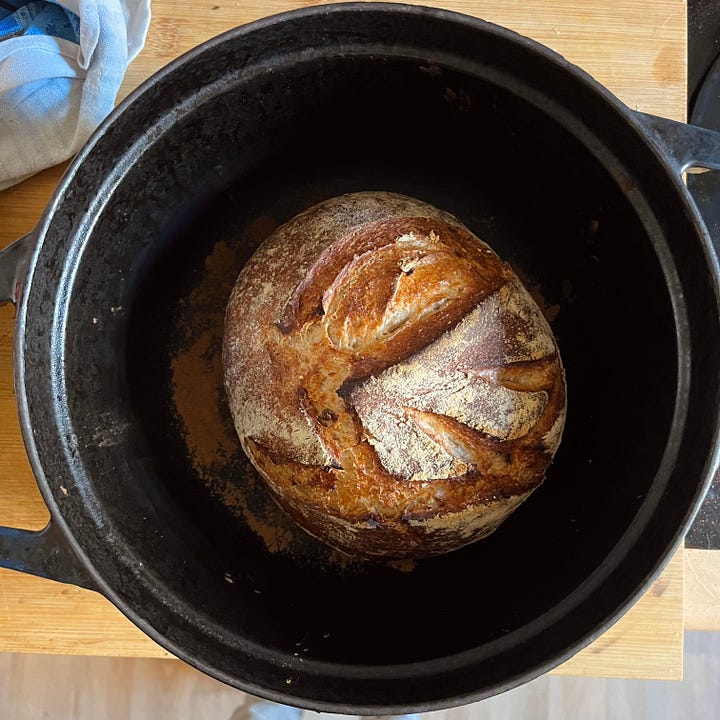
reading, listening
In April, I returned to an old reading habit, which is to keep a chunky hardback on my bedside table and to fit a paperback inside my coat pockets to read on the go.
And the evenings were wild, thanks to Between Two Waters by Pam Burton. Chef Pam Burton opened Inver restaurant on the shores of Loch Fyne in a vow to discover what makes ‘modern Scottish food’. Between Two Waters is a journey in reassessing, learning and reaffirming. It is curious and immersive, disheartening at times (read: opening a restaurant; facing dinners; managing staff and finances) and honest as Burton weaves in anecdotes with wider topics, ranging from colonialism, sustainability and cultural histories. Living in Scotland has taught me many things, but the most heart-and-mind-opening process has been to redefine the word communion in my daily life, through seeing and experiencing new links between people and the land, wildlife and human settlers. Scotland is far more than bad weather and breathtaking landscapes, so is the experience of reading Between Two Waters.
(no, i haven’t dined at Inver yet and, yes, we can go together, if you’d like.)
Inside my pockets, I carried then gulped Clear by Carys Davies. This one is set in 1843, on a remote Scottish island where the sole occupant, Ivar, leads a quiet and isolated life until he finds John Ferguson unconscious on the beach. Ferguson is an impoverished church minister who had been sent to evict Ivar and turn the island into gazing land for sheep, but the two men don’t share a language. [I spoke about the Highlands clearance in my last newsletter.] When Ivar invites Ferguson into his home, the two men begin to learn about one another. Clear is moving, atmospheric, tense; it is subtle and compassionate. I loved it. So much, I can’t recommend it enough, not more than this: let me know how you’ll find it?
At a slower pace, I read the arresting Haweswater by Sarah Hall. Set in 1936 in the northern country of Westmorland, England, this is the story of a forgotten place and its community as they face changes that are forced on them by time and the production demands of the wider country. Jack Liggett is the spokesman for an industrial project to create a new reservoir to supply the growing neighbour city with water; Janet Lightburn is a strong-minded villager. As the two begin an intense affair, their diverging agenda align and collide. Haweswater is clairvoyant, purposeful and sensual.
In audio, I was deeply moved by Séan Hewitt’s memoir, All Down Darkness Wide. We often hear readers say that a book found them at the right time, but I think that we readers find the book, always. Returning to his own love story with Elias, who struggles with severe depression, and contextualising their romance within the wider queer history and the work of poets, Hewitt shows how fearless happiness must be.
I also listened to The Giant O’Brien by Hilary Mantel. If you were here the last couple of months, you will know that I have been on a Mantel journey (/am not that original!). This one may be my favourite so far. This is the true story of the 18th Century Irish giant, Charles O’Brien, who was exhibited in London and dissected by the surgeon John Hunter. It is cynical and lyrical; unapologetic and, like the best of historical fiction novels, it felt unquestionably contemporary. The Giant O’Brien is a brilliant tale of identity, filled with carnivalesque fantasies, unruly bodies and behaviours, and humour.
in the kitchen
If you’re cooking for plenty, savoury tarts will spare you a headache and you may serve your meal in a timely fashion (especially if you buy rolled, puff pastries). Three recipes:
ricotta and tomatoes
400g mixed baby tomatoes (roughly chopped)
4 tomatoes on the vine (sliced thinly)
250g ricotta cheese
1 egg
1 tsp Dijon mustard
1 tbsp balsamic vinegar
salt and pepper
1 ready-rolled puff pastry sheet
Unroll the puff pastry and fit it inside a tart tin; prick the base of the pastry with a fork. In a bowl, beat an egg and stir in the ricotta cheese. Add the Dijon mustard, balsamic vinegar and season with salt and pepper. Mix. Lay the sliced vine tomatoes over the puff pastry and pour the ricotta mixture over it. Scatter the chopped baby tomatoes over the tart. Bake until golden (180C, 20-25 minutes in my kitchen).
/
layered goat cheese and spinach
250g fresh spinach
150g goat cheese (50g sliced; 100g roughly chopped)
3 eggs
1 bunch of chives (roughly chopped)
salt and pepper
1 ready-rolled puff pastry sheet
Unroll the puff pastry and fit it inside a tart tin; prick the base of the pastry with a fork. In a large bowl, beat the eggs and stir in 100g of the goat cheese log. Add the chives, salt and pepper. Mix well. Fold in most of the spinach (about 200g) and mix. Lay a handful of the remaining, loose spinach at the bottom of the pastry, then pour in the eggy-cheesy mixture over it. Add the leftover, loose spinach leaves and top up with the sliced goat cheese. Bake until golden (180C, 20-25 minutes in my kitchen).
/
(anchovy-less) pissaladière
5 medium onions (thinly sliced)
200g black olives (sliced)
3 bay leaves
salt and pepper
1 ready-rolled puff pastry sheet (a classic pissaladière requires a dough closer to a pizza, but we’re thinking crust and prioritising time efficiency here)
In a well-oiled pan, stir in the bay leaves and sweat the onions until translucent. Keep the heat to a minimum and throw in a gulp of water if they brown too fast; this task requires patience, and there is no going around that one. Season with salt and pepper. Unroll the pastry flat and lay over a rectangular baking tray. Fold in the sides into a crust and scatter the onions over the pastry. Top up with black olives. (180C, 20-25 minutes in my kitchen).


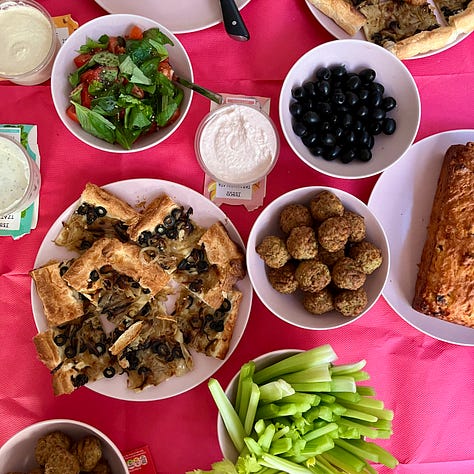
Now, if you’re looking for plentiful pairing sides, two salads:
Joan Didion’s parsley salad (for 35-40 people, according to Didion)
8 bunches of parsley (I like to use 70% of flat leaves and 30% of curly leaves parsley; all roughly chopped, bigger stems removed)
16 tsps of olive oil
4 tsps of balsamic vinegar
150g Parmesan cheese (grated)
In a large bowl, fold in the parsley with the olive oil and the balsamic vinegar. Stir in the Parmesan cheese and mix well.
/
broad beans, feta and mint salad
600g canned broad beans (drained)
30g mint leaves (roughly chopped)
50g wild rocket
200g feta cheese (cubed)
1 lemon (juice and zest)
olive oil, salt and pepper
In a large bowl, mix the broad beans, mint and rocket. Squeeze the juice of a lemon and toss its zest; mix well. Add the feta cheese. Season with olive oil, salt and pepper.
from The Onion Papers
Aloneness isn’t loneliness and, if loneliness is a crowded room, aloneness is a kitchen.
I wrote about being alone (not lonely!) in the kitchen, featuring some readings from Virginia Woolf and George Orwell and a recipe for a minestrone.
/
The next day, I woke up before the sun rose and let the dog out, my breath drawing a luminous fog against the lilac of the early hours, waves exhaling into the gorge below my feet. Leopoldo went for a stroll, and I returned to the stove – firelighters, kindling, logs, kettle – and sat in front of it, my blood vessels unlocking the gates inside me, my fingers swelling red from the heat.
From cooking with fire: an interlude, or some eating and travel notes from two Scottish islands, paired with some thoughts about chasing purpose. Some unmeasured recipes, including a banging pasta, as well.
looking ahead (Glasgow, GMT)
The first day of May wakes up to rain showers, the air warm and the sky brewing. I can see the tomato flowers peaking above the plant raiser as I type this, mushrooms have populated the olive tree pot, yellow and wrinkling caps for a happy soil, and the first leaves have hatched off the wee fig tree’s ends. The pavement smells like a rusty memorabilia box, damp stamp forgotten at the bottom of it, still passed on from one generation on to the other – onwards, subconscious. Meadow pipits may be heard in a high piping choir before they can be seen, revealing the white of their feathers as they slide upwards, then back down to nest on the ground. Beware where you walk, the grass is tall, shh, do listen for the bees, there are few of them and they are precious. Hawthorn flowers have a strong feast to host, taking over the lilies and the bluebells. It is your last call to spot garlic flowers and to make a note for next year’s pesto, should you be a cautious forager. Summer is near, pedalling – peas, mint, asparagus, radishes, it is a great month for those who like to skin and peel vegetables, grabbing a little snack here and there. Frittata, summer orzo recipes – yolky dinners and oily dressings at lunchtime. If the moon will be full on the twelfth day of the month, it will be discreet; if the Era Aquarids meteors will shower, their trail will be hard to see from Earth. May isn’t for the night sky; it sits under the sun. Do keep an eye on the spring tides, which will go far reaching as the days lengthen towards the summer solstice – socks off, wet sand against the sole of your feet, off to comb the shorelines, for pebbles, shells, fossils, sparkly and glossy, pretty natural things, yet do not take what you cannot give back. We define our activism by doing, speaking up and debating: ‘Soyez réalistes, demandez l’impossible’, as the May 68’s slogan reminds us to be realistic and to ask for the impossible. Unite, check on friends; recover; take actions, pals. If nature is cyclic, it is neither definitive nor infinite.
margaux
thank you for reading The Onion Papers. i’m margaux, a writer and cook, and this is my hybrid newsletter. if you enjoy my work, remember to subscribe and/or invite friends to the party as you keep me going <3
Thursdays are for long reads and Mondays are for annotated (unmeasured) recipes (to paid subscribers), both come out every other weeks. Peels, a writer’s almanac, go to all subscribers on the first Monday of the month. you can expect approx. three emails from me each month. O, I write novels too.







